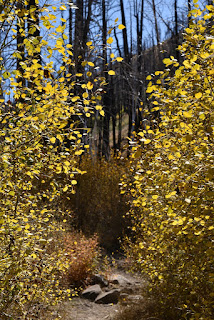Hiked Sunday, October 20.
Back in June 2015, a wildfire burned "near Big Bear." In looking at the maps, I could see that "the Aspen Grove" was right in the middle of it. Yet, despite the devastation, I had to admit that I thought this might be good for the aspen: They're an early succession species. Left undisturbed, they're eventually overgrown and crowded out by conifers. Unless a fire or a snow avalanche clears the maturing forest, aspen groves can be pretty short-lived in their dominance of an area.
Stories emphasizing fact came just months after the fire, when ecologist visited, and journalists wrote that the aspen had, in fact, quickly begun to sprout from the underground runners.
Nonetheless, as expected, an extended closure order kept the Aspen Grove and vicinity off limits to non-scientists. The Forest Service presumably wanted the forest to get a chance to grow tall enough not to be trampled by eager visitors.
Last year, I heard the closure was lifted, but that timber salvage sales kept the road that accesses the area closed. So I waited another year.
This year, I heard conflicting reports as to if the access road was reopened. I swung by the Mill Creek ranger station on Sunday, October 20, to inquire of the Aspen Grove, and was informed that it was open, and that the "regular" way in, via Forest Service Road 1N05, was open.
This used to be a trip I tried to make every fall.
Here's what it looked like on my last visit, in 2014.
My visit in 2013.
My first visit, in 2010.
On this visit, the aspen were only a few feet tall, up to maybe 7-8 feet tall. My observation has been that leaves on smaller aspen turn later than larger aspen, which explains the color still being there so late in the season. However, many of the leaves were also brown, probably from nighttime lows dropping well below freezing, at least a few weeks back.
So, the aspen grove survived and will come back stronger than before. But it will be a decade or more before they again tower against a blue sky. For now, it's just a hint of what's to come.
Something else that changed since my last visit is that this area is now part of "Sand to Snow National Monument." It used to just be part of the San Bernardino National Forest.
The last bit of road (1N05) to the trailhead is pretty rough, but I still managed to navigate it with my Prius. Had to go slow, though, and also had a fair amount of traffic to deal with on this narrow dirt road. I mean, not a lot of cars, but maybe three coming down and three coming up. Depending on where this happens, however, an awkward reverse may be required. But it was still much faster than if I had walked.
Walking would have added about a mile each way. However, I was somewhat pressed for time, and I had been told that the road had been "recently" graded. Still pretty tricky for a low-clearance vehicle, though.
Flash Flood in Water Canyon, and the White Domes | Wanderings #1
-
It's rare that I'm at a loss for where to go, but in trying to figure out a
plan for an early-October trip, I found myself casting around a bit. It's
not t...
1 day ago



























